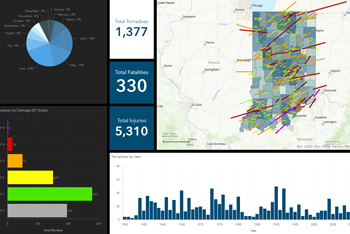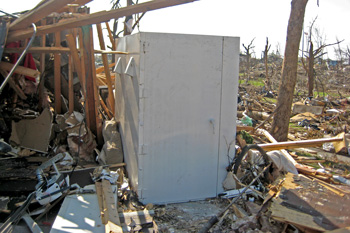Thunderstorms
- Get Prepared
- Nature Safety
- Current: Thunderstorms
During the spring and summer months, thunderstorms that produce lightning, thunder, heavy rain, flooding, strong winds, tornadoes and hail can occur. These storms are extremely dangerous and can appear suddenly with little warning and may only last a few minutes, but they have the strength and power to cause a great amount of damage. In 2024, the National Weather Service received hundreds of reports of severe thunderstorms in Indiana, including more than 300 reports of wind damage and 91 reports of severe hail.
Thunderstorm Safety Tips
Quick Tips
- Check weather forecasts daily, purchase an all-hazard weather radio and have multiple ways to receive weather alerts.
- If caught outside and there are no shelters nearby, avoid taking shelter in or near water, high ground, large open areas, isolated trees, all metal objects and electrical wires.
- Basements, inner rooms and storm cellars provide the best protection during a thunderstorm. Stay in the center of the room, away from doors and windows.
- Stay sheltered until at least 30 minutes after the last sound of thunder.
- In the event of flooding, do not walk or drive through floodwaters.
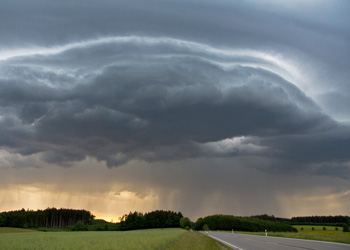
Terms to Know
- Thunderstorm Watch: Conditions for a thunderstorm are favorable.
- Thunderstorm Warning: A thunderstorm has been reported or has been detected by the National Weather Service's weather radar.
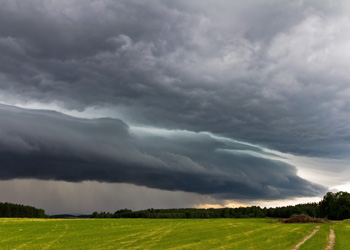
Before a Thunderstorm
Today, meteorologists can accurately track and predict thunderstorms, allowing Hoosiers time to complete simple preparations before a storm occurs.
- Check weather forecasts daily, purchase an all-hazard weather radio and have multiple ways to receive weather alerts.
- Plan outdoor events near a secure shelter where people can go in the event of a storm.
- Keep trees trimmed to prevent limbs from falling onto buildings, cars or people.
- If hail or strong winds are expected, park vehicles under a shelter to avoid damage.
- Make sure preparedness kits are portable for easy transport if evacuation is necessary. Preparedness kits should be tailored to household needs.
- Bring pets indoors before a storm moves into the area. Sheds, dog houses and garages do not provide ample protection from lightning, hail, high winds and tornadoes.
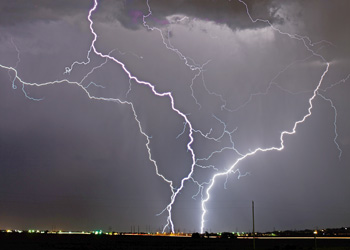
During a Thunderstorm
The middle stage of a storm is typically the most dangerous, because it is the period when tornadoes, heavy rains, lightning, hail and strong winds normally develop. Follow these tips to help ensure the household stays safe during this dangerous time.
- If a thunderstorm is expected, postpone or cancel outdoor activities and monitor weather reports on radio, television, websites and social media.
- If caught outside and there are no shelters nearby, avoid taking shelter in or near water, high ground, large open areas, isolated trees, all metal objects and electrical wires.
- Do not stop at bridges. Strong winds can cause damage to the structure and cause it to collapse, you are not protected from flying debris and vehicles stopped there can block roadways and prevent others from reaching real shelter.
- If caught out in the middle of a body of water, return to shore as soon as possible.
- Basements, inner rooms and storm cellars provide the best protection during a thunderstorm. Stay in the center of the room, away from doors and windows.
- If flooding is possible, evacuate the house and get to higher ground. Know the area and make sure you are familiar with alternate escape routes in the event one is blocked.
- If evacuation is necessary, take pets; however, shelters may not allow pets inside due to sanitary conditions, so plan accordingly.
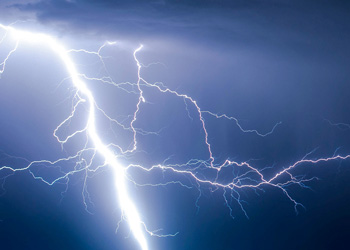
Lightning Safety
Thunderstorms always produce lightning, so it is important for Hoosiers to follow a few safety tips before, during and after lightning strikes.
- Lightning causes thunder. If thunder is heard in a location, then lightning can strike there. The best protection against being struck by lightning is going indoors.
- Lightning can reach temperatures up to 50,000°F, which is hotter than the sun's surface. If it strikes a person, the lightning can cause severe injuries (primarily damage to the nervous system, but also burns). Cardiac arrest can also occur. If an individual is struck by lightning, immediate medical attention is needed, so dial 911 right away.
- Consider buying surge protectors, lightning rods or a lightning protection system to protect the home, appliances and electronic devices.
- Avoid using water, touching electronic equipment and using landline phones. Electricity can travel through plumbing and phone lines.
- Avoid windows and exterior doors that may contain metal components.
- Stay sheltered until at least 30 minutes after the last sound of thunder.
For more information on lightning, see the Lightning Safety page.

After a Thunderstorm
- Do not resume outdoor activities for at least 30 minutes after the last-seen lightning or last-heard thunder.
- If injured, seek necessary medical care.
- Avoid any damaged or fallen power lines and trees. Report them to the appropriate authorities right away.
- In the event of flooding, do not walk or drive through floodwaters. It takes as little as a few inches to knock an adult off his or her feet, and a few inches of moving water can wash most cars away with the current.
- Look for fire hazards and be aware of possible water, gas or oil leaks. Report broken utility lines to the appropriate authorities.
- Take pictures of the damage, both of the building and its contents, for insurance claims.
Resources
Safe Rooms
In an average year, 800 tornadoes are reported nationwide, resulting in 80 deaths and more than 1,500 injuries. Protecting Hoosiers since 2015, the IDHS Safe Room Program has helped residents and communities statewide install hardened structures specifically designed to provide "near-absolute protection" in extreme weather events, like tornadoes.
Safe rooms provide a shield of protection, and studies demonstrate that they can survive winds as high as 250 miles per hour. Built above or below ground level, safe rooms are customizable. They can be small enough for a family to seek shelter or large enough for dozens of school students and staff to hunker down.
IDHS coordinates with the Federal Emergency Management Agency (FEMA) on the grant program to provide partial reimbursement for safe room projects. For more information on community and residential safe rooms, visit the Mitigation page.

